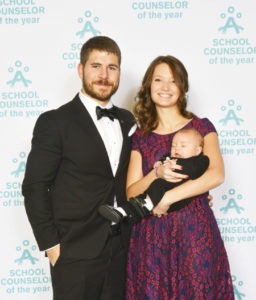
By Michael Howell
Last spring Stevensville Elementary (K-5) School Counselor Lee Starck was chosen by the Montana School Counselors Association as Montana School Counselor of the Year. This put him in the running with school counselors from around the country for an award from the national organization, the American School Counselors Association. Although he didn’t garner a national award, Starck was invited to attend the national conference for the award ceremony at Union Station and was also invited to the White House to attend an event hosted by then First Lady Michelle Obama.
If you ask Starck why he was named Montana Counselor of the Year, he will quickly tell you that it is not about him, it is about the successful programs that the staff and faculty are helping institute at the school. According to him, it is the acceptance of his program suggestions by the administrative staff and the teachers, and their commitment to implementing the programs, that has made the counseling programs at Stevensville successful.
“Counseling is not a one-person job,” said Starck. “It’s a program that is carried out by many people. I’m more of a coordinator of these programs than the one who actually does it.”
The programs are designed to address social and emotional issues that may negatively affect the student’s ability to learn. These can be anything from a family going through a divorce or separation, a new baby in the family, the blending of families, military deployment, or loss of a job.
“A lot of things can impact learning,” said Starck. “Sometimes a student needs to process through some of this before they can re-focus on academics.”
Starck can and does provide short-term counseling, one on one, to individual students. But all twenty-one of the K-5 classrooms also have a weekly support session in which students get lessons in healthy forms of communication, and the need to respect diversity and to “believe in yourself.” Small groups, called Social Academic Instructional Groups, are also formed.
“We use these times to cultivate healthy relationships and encourage healthy communication,” said Starck. They also try to impart the skills to respond to and resist “disrespectful behavior,” like bullying. The school is using the OLWEUS program that defines “bullying” and gives the students the tools they need to address it.
“We show them how to be an ‘up-stander’ instead of just a ‘by-stander’,” said Starck. He said it does not necessarily mean standing up to the bully. It may mean helping someone being bullied get away from the situation. It might mean seeking help or reporting the incident. It could mean getting a few other witnesses to stand up with you to tell the bully that you all know that something’s wrong and it needs to stop.
One program that Starck said he was “the most proud of” is the Busy Bee Co-op. It is a program designed to introduce elementary school kids to the idea of work, of holding down a job. Twenty –one positions have been created that range from helping kindergartners and first and second graders to the bus, paper towel officers who keep the paper towel racks full, or it could mean helping out in the reading lab. All the jobs have a job description and the students apply for a position. If they are accepted, they do the work for two weeks. On completion they get a pin recognizing their accomplishment.
While in Washington, D.C. for the national association meeting, with his wife Adrianna and their two-and-a-half month old son Henry, Starck got a chance to stand on the platform behind Michelle Obama in the East Room of the White House to hear her last public address as the nation’s First Lady. As part of her Reach Higher initiative, Mrs. Obama has championed school counselors and encouraged post-secondary education for students across the country.
“I was so impressed,” said Starck, “especially the last seven minutes when she spoke directly to the youth in America. It was very inspiring.” He said it was an honor and a privilege to be there.
